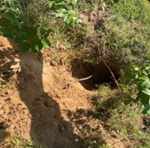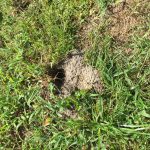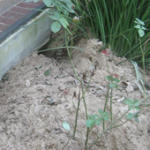Nine-banded armadillos thrive in warmer regions across the United States, especially in the southeast and Southwest. They are known for their hard-scaled armor and clawed toes used for digging.
They are generally shy animals that stay outside. The concern comes from their digging. Armadillos forage is a nuisance. They dig up yards, tear up bulbs, and destroy plants looking for grubs, earthworms, ants, and other insects. Their burrows create the real damage. Burrows can undermine structures and break pipes.
Armadillo Habitats and Behavior
Armadillos leave a spiderweb of scent trails for other armadillos to follow. One armadillo will dig several burrows, and one burrow can be used by several armadillos. They sleep in the burrows and leave in the morning which allows for several armadillos to use your property.
Armadillos stay in the Southern part of the United States because they cannot survive freezing temperatures. Armadillos dig searching for food and create burrows to escape the cold. If the ground is frozen, they can do neither.
Armadillos are a nuisance for homeowners in cities like Tampa, Jacksonville, Orlando, Savannah, Fort Worth, and Dallas. As you get closer to Kansas City and Richmond, armadillos become almost non-existent.
Are Armadillos Dangerous?
Armadillos pose very little danger to people. A scared armadillo usually jumps in the air to distract predators or runs away. When facing a human, it is not likely that the pest will bite. Armadillos have small, peg-like teeth that do not usually cause injury.
While armadillos can carry rabies or leprosy, the number of human cases caused by these pests is unknown. Both diseases transfer through direct contact with infected wildlife or people, so it’s best to avoid touching armadillos.
Because of the danger of disease, homeowners should not try to dispose of dead armadillos on their own. As with any wild animal, handling these critters is safest with the proper equipment and training. Residents with concerns about armadillos can contact the wildlife experts at Trutech.
Armadillo droppings create issues for homeowners in yards, as they not only smell bad but are easily stepped on and difficult to clean up. Feces are often scattered near backyard burrowing sites or around ditches with damp soil. When identifying armadillo scat, look for small groups of inch-long, brown pellets.
Armadillo Holes
Skunks, raccoons, and armadillos will dig holes in your yard for grubs, worms, and other underground creatures. Armadillo holes are usually 1 to 3 inches deep and 5 inches wide.
They also dig burrows big enough for them to crawl into sleep. The burrows resemble a levee system especially as they start to dig horizontally. These horizontal cavities lead to structural damage.
For instance, I’ve seen cases where armadillos burrowed under a pool, cracking the PVC lines and draining water, which caused significant repairs and even structural risk.
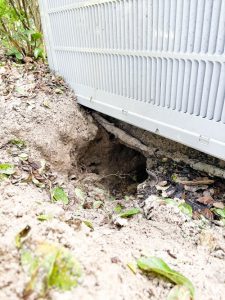
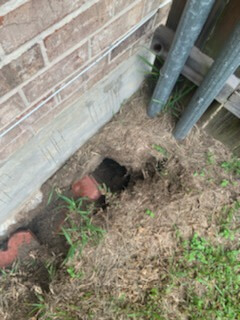
How to Safely Fill an Armadillo Hole
I instruct my team to fill armadillo holes with dirt. We do not use concrete. Because of the scent trails, an armadillo can find that burrow and dig two inches next to the cement to access the underground burrow. This usually leads to a larger hollow under your house, porch, or pool.
The Trutech team in Southwest Florida gently works the dirt around the hole to fill in the system of tunnels.
Get Armadillos Out of Your Yard
If you have an armadillo problem, trapping that one armadillo will not solve the burrow issue. You need continuous protection to keep armadillos out of your yard. In Southwest Florida, we apply a non-pesticide scent deterrent to keep armadillos away. Scent deterrents will not expel an armadillo but they can help keep armadillos out of your yard. We apply the treatment monthly.
Trapping an armadillo takes skill and training. They are predictable, and when searching for food tend to ignore their surroundings. A cage trap with a constructed funnel is effective to catch an armadillo.
Armadillo Prevention in Your Yard
When managing armadillos, it’s essential to use methods that are safe and effective. Here are five ways to handle them:
Bury Fences Around Key Areas
Armadillos are persistent but burying a fence at least 12 inches deep can help protect areas like gardens or foundations from their digging.Eliminate Food Sources
Armadillos are drawn to areas with plenty of ants, termites, beetles, and grubs. Reducing these insects with safe pest control can make your property less attractive to them.Dry Out the Soil
Wet soil is easier for armadillos to dig. If possible, drying out areas near foundations can make it harder for them to burrow.Live Trapping & Scent-Based Deterrents
Trapping an armadillo and relocating it is an option, though deterrents can help. Keep in mind, though, that established armadillos are tough to deter, as they follow scent trails and will likely return to areas where they’ve already created burrows.Install Exclusion Barriers
Place recessed fencing around vulnerable areas. Armadillos tend to dig under structures or dense foliage, so protecting areas like shrubbery near foundations can make a difference.

In Charleston, we installed dig defence around an A/C unit. If you look closely, you can see the armadillo holes around the unit. The barrier kept the armadillo from digging under the unit.
Armadillo Repellents that Do NOT Work
I have had customers in Fort Myers report on every type of DIY armadillo control, and not one of them has worked. I have not seen a DIY scent repellent of ammonia, vinegar, hot sauce, coffee grounds, or anything work at Armadillo control.
I have had some people ask about installing outdoor lights. Armadillos are blind. I have seen an armadillo walk right up to me, only to catch our scent at the last minute, jump up and run away.
Call Trutech in to Get Armadillos Out
We do not recommend trying to catch an armadillo. You might be able to capture one, but it could be dangerous. Armadillos thrash their legs when picked up. Their strong digging claws can cause injuries. If you do trap an armadillo, different states have different regulations regarding release and relocation.


